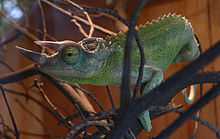Jackson's chameleon
| Jackson's chameleon | |
|---|---|
 | |
| Scientific classification | |
| Kingdom: | Animalia |
| Phylum: | Chordata |
| Class: | Reptilia |
| Order: | Squamata |
| Suborder: | Lacertilia |
| Family: | Chamaeleonidae |
| Genus: | Trioceros |
| Species: | T. jacksonii |
| Binomial name | |
| Trioceros jacksonii Boulenger, 1896 | |
Jackson's chameleon or Jackson's three-horned chameleon (Trioceros jacksonii), is an African chameleon belonging to the chameleon family (Chamaeleonidae).
Taxonomy
Jackson's chameleon was first described by Belgian-British zoologist George Albert Boulenger in 1896.[1]
Its generic name (trioceros) is derived from the Greek τρί- (tri-) meaning "three" and κέρας (kéras) meaning "horns".[2] This is in reference to the three horns found on the heads of males. Its specific name is a Latinized form of English explorer and ornithologist Frederick John Jackson's last name, who was serving as the first Governor of Kenya at the time.[3] The English word chameleon (also chamaeleon) derives from Latin chamaeleō, a borrowing of the Ancient Greek χαμαιλέων (khamailéōn), a compound of χαμαί (khamaí) "on the ground" and λέων (léōn) "lion". The Greek word is a calque translating the Akkadian nēš qaqqari, "ground lion".[4]
The three subspecies, including the nominate, are:
- T. j. jacksonii Boulanger 1896 : Jackson's chameleon
- T. j. merumontanus Rand 1958 : dwarf Jackson's chameleon
- T. j. xantholophus Eason, Ferguson & Hebrard 1988 : yellow-crested Jackson's chameleon
Location
Jackson's chameleons are native to the humid, cooler regions of Kenya and Tanzania, East Africa, and found in great numbers at altitudes over 3,000 m. The subspecies T. j. merumontanus can only be found on Mount Meru and the Arusha Region of Tanzania. The subspecies T. j. xantholophus was introduced to Hawaii in the 1970s and has since established populations on all main islands.[5] This population was the primary source of Jackson's chameleons for the exotic pet trade. However, the exportation of these animals (and many others) from Hawaii for the pet trade has been made illegal to prevent opportunists from willfully establishing further feral animal populations to capture and sell them.
In Captivity
These chameleons do make good pets, but only if taken care of correctly. They require high humidity, and are in general very needy of colder temperatures during the night. Too much heat, or excessive humidity, can cause eye infections and upper respiratory infections in these animals. In captivity, the Jackson's chameleon can be expected to live between five and ten years.[6]
Reproduction
Most chameleons are oviparous, but Jackson's chameleon gives birth to live offspring; eight to 30 live young are born after a five- to six-month gestation. The subspecies T. j. merumontanus gives birth to five to ten live young.
Description
They are sometimes called three-horned chameleons because males possess three brown horns: one on the nose (the rostral horn) and one above each superior orbital ridge above the eyes (preocular horns), somewhat reminiscent of the ceratopsid dinosaur genus Triceratops. The females generally have no horns, or traces of the rostral horn (in the subspecies T. j. jacksonii and T. j. merumontanus). The coloring is usually bright green, with some individual animals having traces of blue and yellow, but like all chameleons, they change color quickly depending on mood, health, and temperature.
These are small to medium-sized chameleons. Their adult size is 12 inches (30 cm) in total length. They have a saw-tooth shaped dorsal ridge and no gullar crest. They attain sexual maturity after five months. The lifespan is variable, with males generally living longer than females.

Jackson's chameleons live primarily on a diet of small insects. They are less territorial than most species of chameleons. Males will generally assert dominance over each other through color displays and posturing in an attempt to secure mating rights, but usually not to the point of physical fights.
References
- ↑ Boulenger, George Albert (1896). "Description of a new chameleon from Uganda". Annual Natural History 6 (17). p. 376.
- ↑ Liddell, H.G., and R. Scott (1980). Greek-English Lexicon, Abridged Edition. Oxford University Press, Oxford, UK. ISBN 0-19-910207-4.
- ↑ Le Berre, François; Richard D. Bartlett (2009). The Chameleon Handbook. Barron's Educational Series. p. 3. ISBN 978-0-7641-4142-3.
- ↑ Dictionary.com entry for "chameleon"
- ↑ "Jackson's chameleon (Chamaeleo jacksonii)". Hawaii Biodiversity Information Network. Retrieved 2013-09-19.
- ↑ Exotic Pets section of About.com
External links
| Wikimedia Commons has media related to Trioceros jacksonii. |
- Chamaeleo jacksonii at the Reptarium.cz Reptile Database
- Jackson's Chameleon Care Information at Caresheets.net
- Chamaeleo jacksonii information from HEAR
- Preliminary study of the behavior and ecology of Jackson's chameleons of Maui, Hawaii (Dr. George H. Waring, Dept. of Zoology, Southern Illinois University)